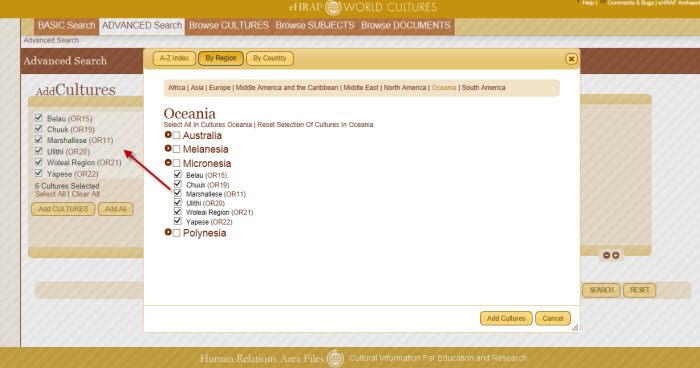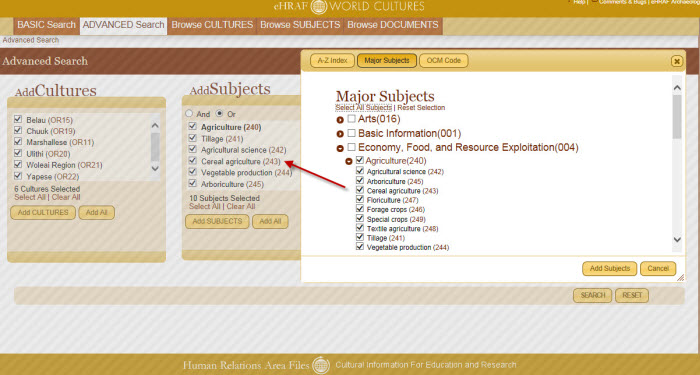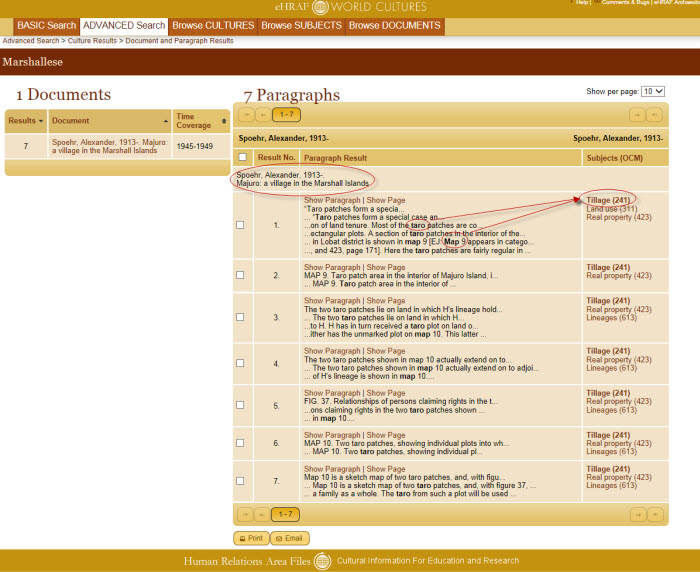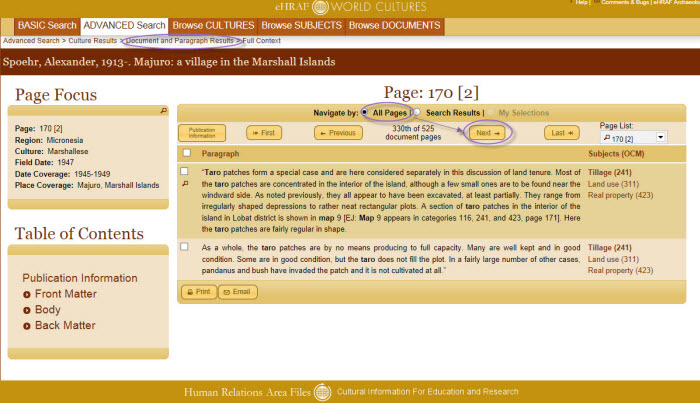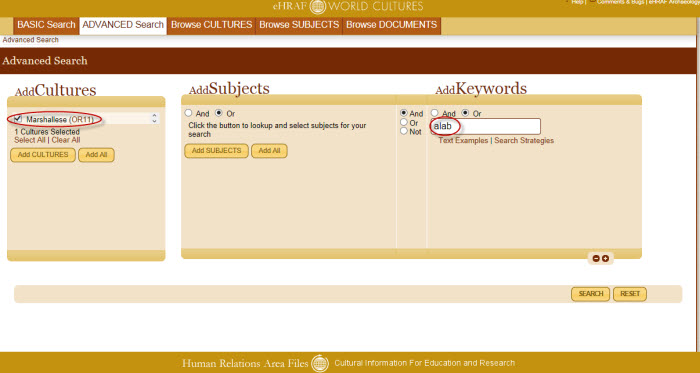Return to Teaching eHRAF: Tile View | Table View
View exercise overview
Class size: Large 50+
Source: Submitted by HRAF member
Learning Objectives
Does the exercise compare 2 or more cultures? No
Subject selection: Single subject specified by teacher
Subjects/OCMS, if applicable: Kinship
Region selection: pre-selected
Region, if applicable: Oceania
Culture selection: Set by teacher
Cultures/OWCs, if applicable: Marshall Islands
Samples:
Classroom Guide
Instructions for navigating eHRAF included? Yes
Assignments for students to complete in groups? No
Assignments for students to complete on their own? Yes
Instructions for Microfiche version? No
Kathryn M. Koziol, Department of Anthropology, University of Arkansas, Fayetteville, AR
*Note to Instructors*: This assignment is suitable for teaching large anthropology classes. The questions draw from specific text document results of Advanced Searches in eHRAF World Cultures. An Answer Key for this assignment is available here. The Answer Key is password protected. Instructors can email hraf@yale.edu to request the password.
In the Marshall Islands plots of land are shared by kin group members. For this assignment, you will be using a specific textual description available in the eHRAF World Cultures database about taro plots and how they are distributed to kin group members. You will also use a map and chart provided in this text to analyze these data and answer the questions below. Be sure to follow all the provided directions as they are given to assist you.
Instructions on how to use an eHRAF Advanced Search
1. Log on to eHRAF World Cultures through your institution’s online library or at the HRAF homepage (https://hraf.yale.edu) by clicking on the brown “eHRAF World Cultures” button in the Access the eHRAF Databases section in the right-hand margin.
2. Once logged on to the eHRAF World Cultures database, click on the Advanced Search tab on top.
3. Click Add Cultures. Select Oceania, then find Micronesia, and select the culture(s) by checking the boxes. Click “Add Cultures” to have the culture names appear on the list in Advanced Search (see Figure 1).
4. Click “Add Subjects”, then click on the arrow for “Economy, Food, and Resource Exploitation”. Select the subjects for “Agriculture” by checking the box(es). Click “Add Subjects” to add them to your list (see Fig. 2).
5. Type the word “taro” into the keyword box to the right and click + in the lower right hand corner (see red circles in Fig. 3). This will add another clause. Type in the word “map” in the keyword box.
When completed, your search should look like Fig. 4, below. Make sure that the Boolean operators (the round radio buttons) “OR” and “AND” are set correctly between subjects, keywords, and clauses. If you select the button labeled “OR” then at least one, but not all, of the subjects under the agriculture heading are included. “OR” (red circle) will increase your search results. Between the 1st and 2nd clause, use “AND” (green circle) as this will “narrow” your search to paragraph results that will have any of the cultures, any of the subjects, but must contain the words “taro” and “map.” Now you have created a powerful search!
6. Click the “Search” button to launch your search.

Fig 4. How the eHRAF Advanced Search should look when completed with added cultures, subjects, and keywords
After clicking “Search”, you should see a page with region and culture results. This particular search should have found 9 paragraphs in 3 documents in 2 cultures. Click on “Oceania” then on the “Marshallese” culture name (see red circle in Fig. 5) to view the paragraph results.

Fig 5. Initial search results in “culture results” view. Red circle shows where to click to obtain more detailed paragraph-level results.
You should see a document with 7 paragraph results for the author and title information on Spoehr, Alexander, 1949. Majuro: a village in the Marshall Islands (see Fig 6). Verify that you are working with the correct document before you proceed.
Specifically, you will be working primarily with text, map, and kinship diagram located on pages 170-176. Click on the “Show Page” option. This will bring you to page 170 of the text describing the taro patches. Notice that your Region, Culture, Field Date, Date Coverage, and Place Coverage are listed to the left your text record (see Fig. 7).
To navigate through the pages, use the NEXT button, the drop down box with the page numbers, or the table of contents to the left. Navigating the document text takes a little practice, but you can always click the “Document and Paragraph Results” link on top of the screen to return to your starting point.
Questions – 25 Total Points
1. What is the document ID for this source? Hint: you might want to click around for some of the background/publication information to find this information. 1/25 points
2. What is the place coverage listed for this data? 1/25 points
3. What is the field date listed for this data? 1/25 points
4. What is the culture listed? 1/25 points
Now answer the following questions using the kinship diagram from page 173, the map from page 175, and the text from pages 170-176. There is enough information in this section to apply your knowledge of the class materials and figure out the answers to questions below that are not specifically stated by Spoehr (1949). Questions marked with an asterisk * will require you to perform an additional search in the eHRAF World Cultures database. You might want to perform that search in a separate tab or window so that you do not lose your original search.
5. Where are most of the taro patches concentrated on the island? 1/25 points
6. What are the three parts of the explanation for why the land patches are not producing to full capacity, as revealed on the 331st page (out of 525 document pages)? 1/25 points
7. Why is it that only some of the figures are shaded (silhouetted) on the kinship diagram on page 173? 1/25 points
8. Why is person G not a member of this kin group? 1/25 points
9. Describe how person G received land rights. 1/25 points
10. Why is person I not a member of this kin group? 1/25 points
11. Describe how person I received land rights
12. Using the terms you learned in class and/or from your textbook, what type of kin relationship (i.e., consanguineal, affinal, fictive, clan member, etc.) does G have to the rest of the lineage represented on kinship diagram from page 173? 1/25 points
13. How is land inherited? (i.e., matrilineal, patrilineal, etc.) 1/25 points
14. *What does alab mean? For this question you will want to complete a new Advanced Search query. Now you will be able to specify the culture and use alab as your text keyword. (see Advanced Search, Fig 8). To receive credit for your response you must also include the author, year, page number and title of your source. 1/25 points
15. Based on the description in the Spoehr text, describe in your own words the role of the alab in regards to the distribution of taro patches. 1/25 points
16. Who are the primary cultivators of the taro plots? 1/25 points
17. Who does the food go to when taro plots are cultivated by the family as a whole? 1/25 points
18. What is this communally harvested food used for? 1/25 points
19. What type of economic exchange (i.e., reciprocity, redistribution, market economy, etc.), as learned from your lectures and/or from your textbook, does the behavior of these chiefs best describe? 1/25 points
20. Briefly describe what taro is. You may use an internet search engine like Bing or Google to find websites with the answer. You need to provide the URL of the website that you choose to answer this question to receive credit for your answer. 1/25 points
General Questions about the HRAF and eHRAF World Cultures
21. What is HRAF and when was this organization founded? 1/25 points
22. What does the acronym OCM stand for and how does it work? 1/25 points
23. Provide the OCM subject codes for the following topics: 1/25 points
Special Burial Practices and Funerals _____
Cereal Industry _____
Religious and Educational structures _____
Illegal Entertainment _____
24. Navigate from the eHRAF homepage to the eHRAF World Cultures database and find the “Browse Cultures” section. Then answer the following: 1/25 points
What are the eight regions in which you can begin a search? _________, _________, _________, _________, _________, _________, _________, and _________.
25. How many different cultural, ethnic, religious, and national groups are represented in the various HRAF formats (print, microfiche, CD, and online)? Hint, this type of information can be found on HRAF’s homepage and would include descriptions of what the original HRAF Collection of Ethnography was created for. 1/25 points
Cultures in the various HRAF formats: _____
